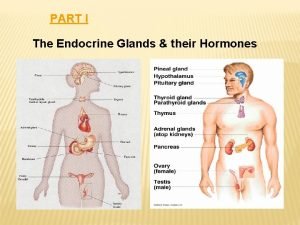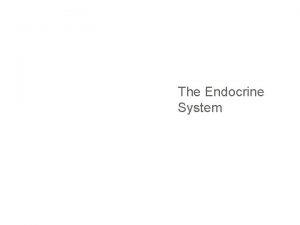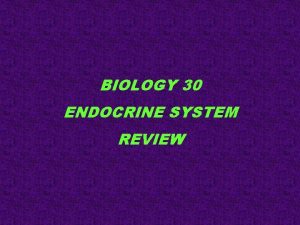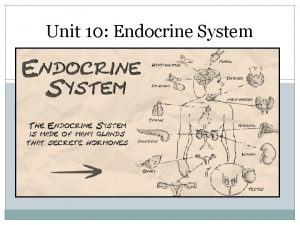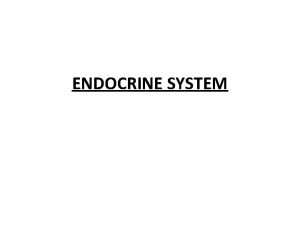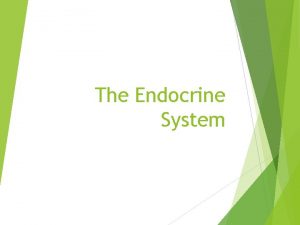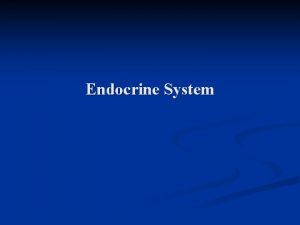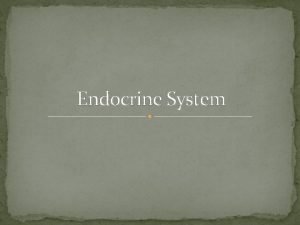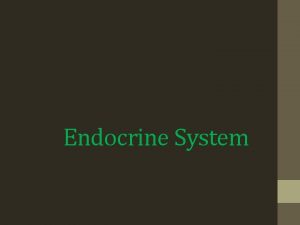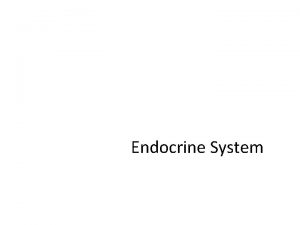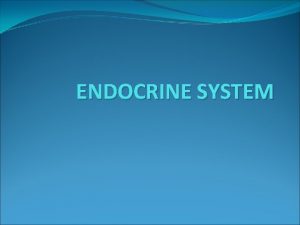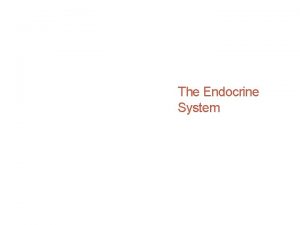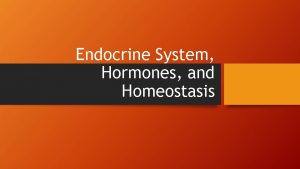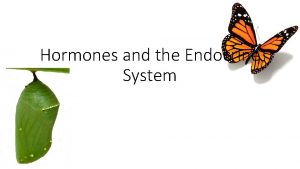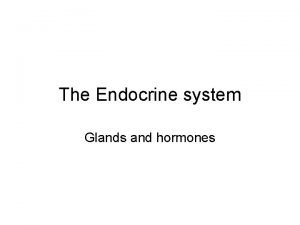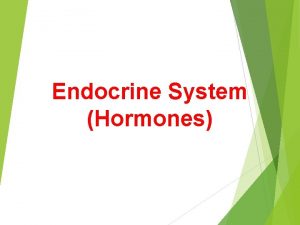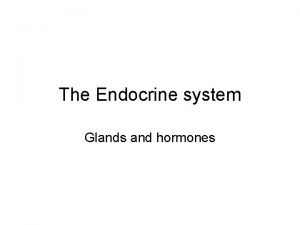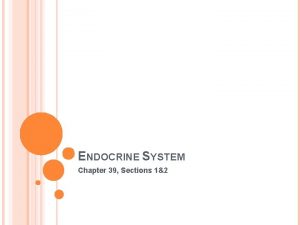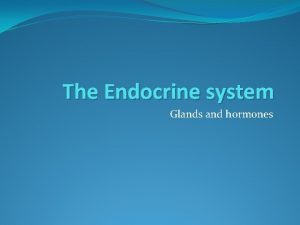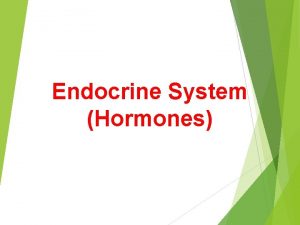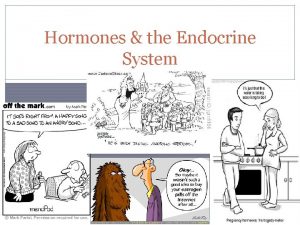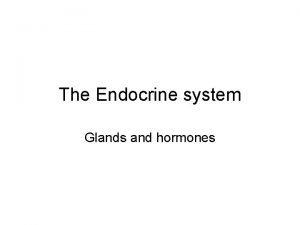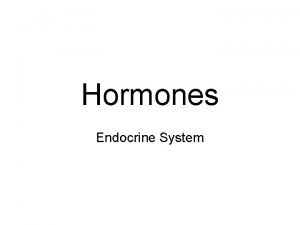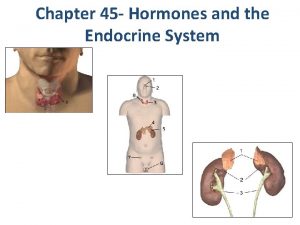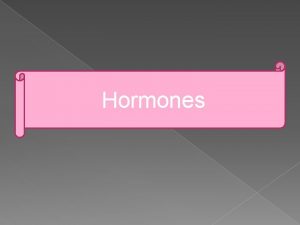ENDOCRINE SYSTEM Hormones Selfregulating system Production Extremely small

























- Slides: 25

ENDOCRINE SYSTEM

Hormones • Self-regulating system • Production – Extremely small amounts – Highly potent • Affect: – Growth – Metabolism – Behavior • Two categories: – Lipid (Steroid) – Amino acid



Pituitary • Also known as hypophysis • Located beneath brain • Divided into two lobes: – Anterior • Releases six hormones – Posterior • Releases two hormones

Thyroid and Parathyroids • Thyroid gland – Located on either side of larynx and upper trachea – Two lobes – Secretes mixture of hormones • Parathyroid glands – Located at posterior surface of thyroid – Affect calcium metabolism

Adrenal Glands • Hormones produced involved in body’s response to stress • Located atop each kidney • Divided into two regions – Outer cortex produces: • Steroid hormones • Cortisol • Aldosterone • Sex hormones – Inner medulla produces • Epinphrine • Norepinephrine

Pancreas • Islet cells produce two hormones: – Insulin • Increases cellular use of glucose • Decreases sugar levels in blood – Glucagon • Decreases cellular use of glucose • Increases sugar levels in blood

Other Endocrine Tissues • Thymus – Secretes thymosin • Gonads – Secrete sex hormones • Prostaglandins – Group of hormones produced by many cells – Variety of effects • Uterine contractions • Inflammatory response • Vasomotor activities

Clinical Aspects of Endocrine System • Endocrine diseases result from: – Hypersecretion – Hyposecretion – Secretion at wrong time – Failure of target tissue to respond • Causes may originate: – In gland itself – With hypothalamus or pituitary failing to release proper amount of hormone stimulators


Pituitary • Pituitary adenoma usually increases secretion of growth hormone – Excess in children causes gigantism – Excess in adults causes acromegaly • Treatment – Surgery – Drugs to reduce hormone level in blood

Pituitary (con’t) • Panhypopituitarism – Hypofunction of pituitary – Caused by tumor or interruption of gland’s blood supply – Widespread effects • Lack of ADH – Results in diabetes insipidus • Kidneys with diminished ability to conserve water • Symptoms include: – Polyuria – Polydipsia

Thyroid • Deficiency of thyroid hormone causes: – In infants • Physical retardation • Mental retardation • Congenital hypothyroidism – In adults • Myxedema • Hyperthyroidism – Common form is Graves disease – May result in goiter (enlarged thyroid) • Not always results from thyroid malfunction

Parathyroids • Overactivity causes high level of calcium in blood – Calcium obtained from bones – Possible development of kidney stones • Underactivity results in decreased calcium – May cause: • Tingling • Numbness • Tetany

Adrenals • Addison disease = hypofunction of adrenal cortex – Caused by: • Autoimmune destruction of gland • ACTH deficiency – Results in: • • • Water loss Low blood pressure Electrolyte imbalance Weakness Nausea Increase of brown pigmentation

Adrenals (cont’d) • Cushing syndrome = excess of adrenal cortisol hormones – Caused by: • Therapeutic administration of steroid hormones • Tumor – Results in: • • • Moon-shaped face Localized obesity Weakness Hirsutism Fluid retention

Pancreas and Diabetes • Diabetes mellitus – Most common endocrine disorder – Failure to use glucose effectively – Excess glucose causes hyperglycemia – Two types: • Type 1 (juvenile-onset or insulin-dependent) • Type 2 (adult-onset or non-insulin dependent)

Type 1 Diabetes • Usually appears in children and teenagers • Caused by failure of pancreatic islets to produce insulin • For proper management: – Monitor blood sugar levels – Give insulin in divided doses – Regulate diet

Type 2 Diabetes • Initiated by cellular resistance to insulin • May result in: – Metabolic syndrome – Hypoglycemia – Insulin shock • Diagnosed by measuring levels of glucose in blood plasma • Most cases linked to obesity • Another form is gestational diabetes mellitus





 Tropic hormones hypothalamus
Tropic hormones hypothalamus Chapter 45 hormones and the endocrine system
Chapter 45 hormones and the endocrine system Alir proses produksi produk multimedia adalah
Alir proses produksi produk multimedia adalah Endocrine system and reproductive system
Endocrine system and reproductive system Endocrine system vs nervous system
Endocrine system vs nervous system Lympathic
Lympathic Endo crine gland
Endo crine gland Endocrine system
Endocrine system Major endocrine glands male and female
Major endocrine glands male and female Parts of the endocrine system
Parts of the endocrine system The body's speedy electrochemical communication network
The body's speedy electrochemical communication network Comparison of endocrine and nervous system
Comparison of endocrine and nervous system Steroids endocrine system
Steroids endocrine system Endocrine system fact
Endocrine system fact Rat appendix
Rat appendix Metabolic action of growth hormone
Metabolic action of growth hormone Exocrine glands are ductless
Exocrine glands are ductless Chapter 7:13 endocrine system
Chapter 7:13 endocrine system Stimulus endocrine system
Stimulus endocrine system Humoral stimulus
Humoral stimulus Hypothal
Hypothal Biology 30 endocrine system
Biology 30 endocrine system Pencreas
Pencreas Chapter 23 the endocrine system
Chapter 23 the endocrine system Endocrine system analogy
Endocrine system analogy The endocrine system consists of
The endocrine system consists of









